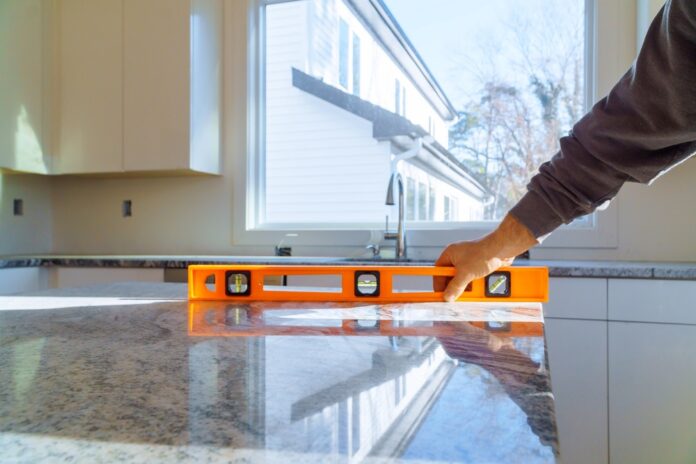Granite has become a cornerstone material in modern construction and design, revered for its durability, elegance, and timeless appeal. Whether adorning kitchen countertops, bathroom vanities, or fireplace surrounds, granite’s natural beauty elevates any space. However, working with this robust stone demands precision, the right techniques, and importantly, the appropriate granite tools and supplies. This comprehensive guide will delve into the essential tools and techniques that empower both professionals and DIY enthusiasts to achieve outstanding results when working with granite.
From cutting and shaping to polishing and maintenance, we’ll explore how the correct tools granite not only enhance craftsmanship but also boost efficiency, ensuring your granite projects are completed with finesse and ease. By understanding the purpose and proper utilization of each tool, you can transform raw granite slabs into stunning masterpieces, while simultaneously optimizing your workflow and minimizing potential hazards.
Cutting and Shaping Granite: Precision and Power
The process of transforming a raw granite slab into a bespoke countertop or intricate design begins with precise cutting and shaping. This stage demands tools that deliver both power and accuracy, allowing you to achieve clean cuts and intricate shapes while maintaining the integrity of the stone.
- Diamond Blades: These are indispensable for cutting granite. Available in various diameters and configurations, diamond blades are engineered to slice through granite with ease. Wet cutting blades, used with a continuous flow of water, are ideal for minimizing dust and prolonging blade life. Dry cutting blades offer convenience for smaller cuts or when water isn’t readily available. Furthermore, the choice between segmented and continuous rim blades depends on the desired finish and the thickness of the granite. Segmented blades offer faster cutting for thicker slabs, while continuous rim blades provide smoother cuts, especially for thinner materials. A granite a frame can provide the necessary stability and ensure accurate cuts.
- Angle Grinders: These versatile tools are crucial for making precise cuts and shaping granite edges. Equipped with a diamond blade, angle grinders provide the control needed to create intricate curves and angles. However, safety is paramount when operating these powerful tools. Always wear appropriate safety glasses and gloves, and ensure the granite slab is securely held in place, preferably with a granite A-frame, to prevent movement during cutting.
Granite A-frames are sturdy support structures essential for safely and effectively cutting granite slabs. By securely holding the slab at a convenient working angle, the A-frame minimizes the risk of accidental breakage and ensures stability during cutting operations. This not only enhances safety but also improves cutting accuracy by providing a stable platform for the angle grinder. Investing in a robust and appropriately sized A-frame is crucial for any serious granite project. When choosing an A-frame, consider factors such as weight capacity, height adjustability, and overall stability to ensure it meets the demands of your granite projects.
Handling and Safety: Prioritizing Well-being
Working with granite, a heavy and unforgiving material, necessitates careful handling to prevent injuries and ensure a safe working environment. Proper tools and techniques are crucial for minimizing risks and promoting well-being throughout the fabrication process. Even seemingly simple tasks like applying a cleaning solution can pose risks if proper precautions aren’t taken.
Suction Cups: These invaluable tools provide a secure grip for lifting and maneuvering granite slabs, reducing the risk of strains and back injuries. By creating a vacuum seal, suction cups allow for controlled movement of heavy slabs, preventing accidental drops that could damage the material or cause harm. When selecting suction cups, ensure they have a sufficient weight capacity for the size of the slabs you’ll be handling. Regular inspection of the suction cups is also vital to ensure they are in good working order and maintain their vacuum effectively.
Personal Protective Equipment (PPE): Safety should always be a priority when working with granite. Wearing appropriate PPE is crucial to protect yourself from potential hazards, even when performing tasks like cleaning and polishing. Gloves provide a firm grip and protect hands from sharp edges, abrasive materials, and potential irritants in cleaning solutions like Granite Gold Clean & Shine. Safety glasses shield eyes from flying debris generated during cutting and polishing, and also from potential splashes when using cleaning solutions. Dust masks are essential to prevent the inhalation of granite dust, which can pose respiratory risks. Always prioritize safety by using the appropriate PPE for each task.
Proper Lifting Techniques: Even with the assistance of suction cups, lifting heavy granite slabs requires proper technique to avoid injuries. Bend your knees and keep your back straight when lifting, using your leg muscles to do the heavy work. Avoid twisting or jerking movements, which can strain your back. If a slab is too heavy to handle comfortably, seek assistance from another person or utilize mechanical lifting aids.
Maintenance and Care: Preserving Granite’s Beauty
Granite, renowned for its durability, still requires proper care and maintenance to preserve its natural beauty and longevity. Implementing a regular cleaning and maintenance routine is essential to protect your investment and keep granite surfaces looking their best.
Cleaning Solutions: Using the right cleaning solutions is crucial for maintaining granite’s shine and preventing damage. Avoid harsh chemicals or abrasive cleaners, which can dull the surface or etch the stone. Instead, opt for pH-neutral cleaners specifically designed for granite, such as Granite Gold Clean & Shine. These cleaners effectively remove dirt and grime without harming the delicate finish of the granite. Regular cleaning with a suitable granite cleaner helps to prevent staining and preserve the stone’s natural luster.
Sealing Granite: Granite is a porous material, meaning it can absorb liquids and stains if left unprotected. Sealing granite is a crucial step in preventing this absorption and protecting the stone from damage. Sealers create a barrier that repels liquids and stains, making cleaning easier and preventing discoloration. The frequency of sealing depends on the type of granite and the sealer used, but it’s generally recommended to seal granite countertops at least once a year.
Regular Maintenance: In addition to cleaning and sealing, regular maintenance practices can help prolong the life and beauty of your granite surfaces. Avoid placing hot pots or pans directly on granite, as extreme temperature changes can cause cracking. Use coasters under glasses to prevent water rings and wipe up spills promptly to avoid staining. By incorporating these simple practices into your routine, you can ensure your granite surfaces remain beautiful and functional for years to come.
Conclusion
Investing in the right tools granite and supplies can significantly elevate your granite craftsmanship and efficiency. From precision cutting and shaping to meticulous polishing and maintenance, the tools of granite discussed in this article empower you to create stunning granite masterpieces that will enhance any space. Remember, safety is paramount throughout the entire process. Always wear appropriate PPE and follow proper handling techniques to prevent injuries. By investing in quality tools granite, supplies, and care practices, you can ensure that your granite surfaces remain a source of beauty and functionality for years to come.
Find a Home-Based Business to Start-Up >>> Hundreds of Business Listings.
















































